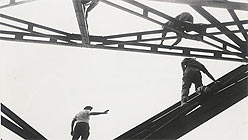BG: Did your organization of this show start with any particular pieces? Or was it just a general concept?
SP: It started as an idea, and the beginning of it was looking at the work of Edgar Degas, believe it or not! He was very interested in photography and he made a lot of photographs. He made pictures of his models that he arranged, but they were presented as though they were spied on. I thought that was completely fascinating — why would someone as important as he be interested in the use of photography as a spying medium? It had to do with his own personal aesthetic, but once you get started in that, then you realize how amazingly broad this topic is.

Garry Winogrand, New York, 1969; c. Estate of Garry Winogrand, courtesy Fraenkel Gallery, San Francisco.
SP: I also looked at the work of Helen Levitt, and she was interested in making pictures of people who didn’t realize that they were being photographed. So all of a sudden, this idea expanded: how do you explain street photography without actually dealing with the surveillance aspect of it? And then it became a very big subject: it wasn’t only street photography, it’s the ways we look at sex, the ways we understand important people, and then this weird territory where people like celebrities are being aggressively looked at. What does that mean to us as a culture? Where does this come from? Examining the interest that we have in violence is a necessary part of modern life. And the contemporary photographs are all about surveillance, obviously.
BG: Do you think there’s any correspondence between the gesture of taking a photograph of someone who is not looking, and staging a photograph to appear as though someone is not looking?
SP: …Oh, yeah…
BG: I’m thinking of all the Facebook photos — those self-portraits — where people specifically look away from the camera as though they had been caught unawares. What do you think is behind that?
SP: It’s an affect, that we want to be photographed as though it’s real, but it’s actually not real. I think this is the big issue now in photography, whether it’s staged or isn’t staged. It comes back to the idea of photography being a medium of truth telling. It’s a very interesting medium; it seems absolutely clear and yet is so mysterious.
BG: I find it interesting that this exhibition came from England, where surveillance culture is just outrageous. Do you know what the reaction was, over there?
SP: It was tremendously interesting to the English for that very reason. The Tate is a much more public institution than almost any other institution in the world, it has millions of visitors a year. And I can’t remember how many millions of people came to see the show, but it was huge, there was a lot of discussion about it. There was another show about surveillance [Rhetorics of Surveillance: from Bentham to Big Brother at ZKM Center for Art and Media in Karlsruhe] about ten years ago in Germany and it was very theoretical.But in England they have the whole craze, really, for outfitting public spaces with surveillance cameras. There was a child in Scotland who was abducted and killed by two older kids, and that’s what started it all. It was before the al Qaida bombings, it was before all of that. It wasn’t political; the idea was purely to save children’s lives, that’s where it started.

Tazio Secchiaroli, “Anita Ekberg and Husband Anthony Steel, Vecchia Roma,” 1958.
BG: Which is different from what’s happening right now. On one hand we want to have our personal privacy — when we dictate it! — but on the other hand we want to look as though we’ve been caught on camera in some “real” moment. How do you tease those apart? It’s so complicated, this relationship that we have to an image of ourselves.
SP: Yes, it’s extremely strange.
BG: Are there any pieces in the exhibition that embody what you want people to take away from this?
SP: The Degas picture. And, obviously people like Weegee play an enormous role here. And there are certainly pictures that mean a lot to me. The early photograph by Paul Strand of the man who’s sitting on the sidewalk, a poor man, on the street in New York. He’s revealing his inner dislocation or inner anxiety — it’s a picture of someone’s raw psychological anxiety. It’s a very moving picture, done by a guy who was trying to learn about Cubism and elevate photography to a formalist practice. And, at the same time he’s making these pictures of very poor people on the streets without their knowledge of it. That, I would say, is a touchstone.





